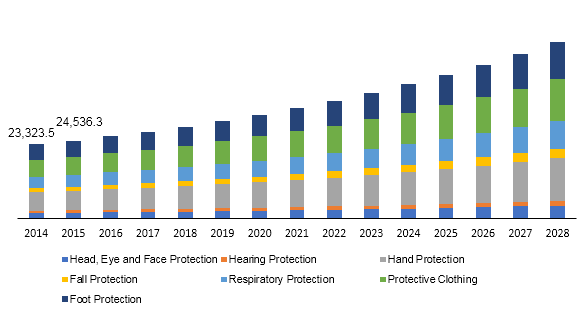
Personal Protective Equipment (PPE) Market Size and Forecast By Product Type (Head, Eye and Face Protection, Hearing Protection, Hand Protection, Fall Protection, Respiratory Protection, Protective Clothing, Foot Protection) By Application (Mining, Manufacturing, Construction, Oil & Gas) And Trend Analysis, 2015 - 2028
- Published: March, 2018
- Format: Electronic (PDF)
- Number of pages: 85
- Industry: Green Building Materials
Industry Insights
The global personal protective equipment (PPE) market size was valued at USD 23,323.5 million in 2014 and is expected to witness a significant growth, pertaining to the rise in the number of occupational fatalities coupled with the growing awareness towards employee’s safety for enhancing efficiency and better production output in the manufacturing and industrial segment.
Personal Protective Equipment (PPE) market revenue, by product type, 2015 - 2028 (USD Million)

There is a lack of awareness towards employee health and safety, shortage of protective gear and minimal industrial fatalities in the emerging economies and government is taking several initiatives to implement proper rules and regulations regarding the use of protective gear on account of which the demand for PPE is anticipated to rise over the forecast period. Additionally, technological innovations, along with changing consumer need for protective equipment which fashionable and provides safety at the same time is further estimated to augment the market expansion.
Segmentation by product type
• Head, Eye and Face Protection
• Hearing Protection
• Hand Protection
• Fall Protection
• Respiratory Protection
• Protective Clothing
• Foot Protection
The hand protection segment occupied more than 25% of the revenue share in 2014 and is expected to grow over the forecast period owing to the rising need and awareness to protect employees from the danger of hand injuries in manufacturing industries such as pharmaceuticals, food, chemicals, manufacturing and construction. Growing number of work place injury cases of hand cuts, arm injuries and abrasions is expected to fuel market demand hand protection equipment during the forecast period.
The protective clothing segment is expected to grow at a CAGR of 6.8% on account of the protection offered by such clothes to the workers working in harsh environment and extreme conditions. Durable protective clothing is able to withstand high pressure damage and is abrasion resistant. These products are best suited for environments which emit heat & flame, high radiations and offers less mechanical protection. Disposable personal protective clothing complies with plastic disposable regulations and finds its application for general protective clothing including clean room clothing, limited general use clothing and microbial protective clothing. These products are used in work environments with minimalistic hazardous or non-hazardous contaminants and medium-to-low risk to human health and safety, which is anticipated to fuel the market growth over the forecast period.
Head, eye and face protection equipment are used where protection in harsh environments such as shoring, shipyard employment and construction industry which employ the use of chemicals, radiological irritants and hazardous substances which can damage vision and hearing power. Hearing protection is used in workplace conditions where noise cannot be reduced at the source. Earplugs and sound detectors are worn in order to prevent occupational deafness.
Respiratory protection equipment protects workers from harmful dusts, insufficient oxygen environments, smokes, fogs, mists, vapors, gases, and sprays. These hazards may cause lung impairment, cancer, diseases, or death. Protective footwear including safety shoes and boots are required to be worn by all workers to prevent injuries from rolling or falling objects from an elevation. It includes rope grab, shock-absorbing lanyard, cross arm strap, retractable lifeline, full body harness, restraining belt and carabineer.
Segmentation by application
• Mining
• Manufacturing
• Construction
• Oil & Gas
• Others
The manufacturing segment occupied more than 44% of the revenue share in 2014 and is expected to grow over the forecast period on account of the rise in the number of workplace hazards during various primary and ancillary processes involved in manufacturing industry such as welding, grinding and torch cutting. According to Bureau of Labor Statistics, 84% of employees who suffered head injuries were not wearing head protections at the time of the injury. Therefore, rising number of workplace fatalities is anticipated to increase the demand of PPE in the industry. Growing manufacturing segment in the emerging economies such as India, China, Brazil, Japan and Singapore is anticipated to augment the product demand over the forecast period. Stringent government regulations regarding safety of employees at workplace are forcing employers to adopt personal protective equipment.
The use of personal protective equipment in the construction industry is estimated to grow fastest at a CAGR of 6.9% over the forecast period. Personal protective equipment in construction industry is used to protect employees from free fall and head, hand, & foot injuries. Personal protective equipment such as fall arrest, head, eye & face protection, foot protection are provided by employers at their own costs to employees for their safety. Overhead costs arising due to workplace fatalities are anticipated to augment product demand in the industry over the forecast period.
Competitive landscape
The PPE market is competitive and fragmented in nature with the existence of a major personal protective equipment suppliers and a huge number of small players. As well. Major players include Honeywell International Inc., 3M, MSA, DuPont and Ansell. The leading players in the market are growing their scope by increasing their focus on the new technologies and innovation to reduce the weight and increase the efficiency of personal protective equipments. The major companies are focused on improving brand positioning by constant innovations, product differentiation and introducing new cost effective production techniques. The players are also aiming on streamlining their manufacturing processes to increase profitability.

Choose License Type
- World's largest premium report database
- Transparent pre & post sale customer engagement model
- Unparalleled flexibility in terms of rendering services
- Safe & secure web experience
- 24*5 Research support service
